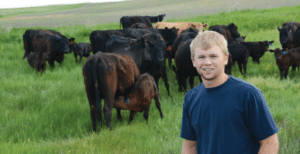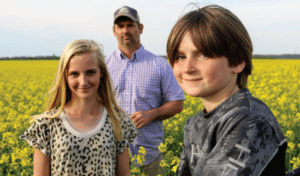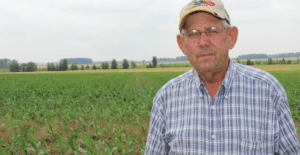Opportunities to Improve Your Bottom Line in Row Crops
Source: Cover Crop Economics
When it comes to making the big decisions about managing a farm, whether it’s to grow a new crop, buy an expensive piece of equipment or upgrade infrastructure, farmers are business people first. If the idea doesn’t work out on paper, either by cutting costs or raising revenue, then it likely won’t happen.
With the decision to adopt cover crops, a conservation practice that is becoming increasingly popular throughout the country, the economic picture can admittedly be hard to decipher at first. This is because a simple, one-year budget analysis of cover crops, one that just compares the cost of seed and seeding to the impact on the next crop yield, may indeed show a loss.
Yet most farmers who have long-term experience with cover crops and who carefully keep their books have discovered that cover crops do in fact pay. These farmers usually look at cover crops from the broad, holistic standpoint of how they will improve the efficiency and resiliency of the entire farm over time.
“Look at cover crops as an investment rather than a cost,” advises Justin Zahradka, who farms 900 acres in North Dakota and has been planting cover crops since 2011. Cover crops allow Zahradka to extend the grazing season for his livestock, grow his soil’s organic matter and maintain more consistent yields in wet or dry years.
Or, as he puts it, cover crops help him “be more productive on each acre.” (Zahradka’s farm is profiled later in this bulletin.)
Every business-savvy farmer knows that some purchases cannot be evaluated solely on their first-year financial impact. Buying new farm machinery or applying lime to acidic soils are typical examples of purchases that come with longer pay-back periods. Similarly, crop insurance seldom pays for itself the year it is bought. In the same manner, because cover crops gradually improve soil health and the productivity of fields, their economic value is best understood over a multi-year period.
Under circumstances where cover crops are the only change made to farm management, it can take a few years for cover crops to fully pay for themselves. But, as farmers gain experience and expand the number of fields that are cover cropped, they find a variety of ways to accelerate the return on their investment. In some situations, cover crops can provide a positive return in the first year or two of use. This bulletin will describe seven specific situations in which the profitability of cover crops can be accelerated.
These situations reflect both common production challenges that row crop farmers face (for example, herbicide-resistant weeds) and opportunities (for example, the transition to no-till). Much of the baseline economic information that underlies the financial analysis of these situations derives from five years of data from the National Cover Crop Survey conducted by SARE and the Conservation Technology Information Center (CTIC) for the 2012–2016 growing seasons. Farmer profiles share real-world examples of how the multifaceted benefits of cover crops translate into profitability.
Three key takeaways on cover crop economics have become clear through our analysis:
1. A thorough evaluation of cover crop economics looks at the overall changes farmers typically make to crop management over a multi-year period of using cover crops. Farmers who are most satisfied with their return on investment take a holistic look at how they manage their overall cropping system and often make a suite of changes that improve overall efficiency, rather than alter just one practice (such as planting a cover crop).
2. In most cases, farmers need to use a multi-year timeline to evaluate the return from cover crops, much as they would for applying lime or buying equipment. While an economic return can come relatively quickly in certain situations, such as when using cover crops for grazing or to control herbicide-resistant weeds, the maximum return will build steadily over several years as the soil improves and as the farmer gains experience incorporating cover crops into their overall system.
3. One of the most-often-cited economic benefits of cover crops by experienced users is their impact on the resiliency of the cropping system. Farmers are finding that by helping to minimize drought related yield losses or sometimes allowing earlier planting in a wet spring, cover crops serve as a type of crop insurance. As with ordinary crop insurance, the premium you pay for cover crops will pay off big in some years, but not every year.
USDA Census of Agriculture
Cover crop acreage increased 50% nationally from 2012 to 2017.
How to Get a Faster Return from Cover Crops
When evaluating average fields in average weather conditions, it can take three or more years for cover crops to pay off if no incentive payments are obtained and no special circumstances exist. However, every farmer has their own challenges and opportunities that can affect this picture. Therefore, when evaluating the economics of cover crops, it can be helpful to consider common situations or scenarios under which they will pay for themselves more quickly, often within a year or two. Seven situations in which cover crop profits are accelerated are listed here and then described in more detail in a later section of this bulletin.
Many farmers may experience more than one of these situations. Cover crops will quickly pay off when two or more of these situations occur together. The farmers profiled in this bulletin reflect this view that cover crops are most profitable when they provide benefits in multiple areas.
For example, Tennessee farmer Ray Sneed plants a five-species cover crop mix with multiple goals in mind. “Each species has a job, and those jobs are based on where I have problems,” says Sneed, who farms 10,000 acres of corn, soybeans, wheat and cotton.
His mix includes tillage radishes, crimson clover, wheat, cereal rye and turnips. Their primary jobs are to scavenge nutrients, alleviate compaction, improve water infiltration and suppress weeds. After six years of cover cropping, Sneed is saving money by using less irrigation water, fertilizer and herbicide. “We’re learning that we can use some of these species to offset the costs of growing our crops,” he says.
Before getting into the detailed economics of these seven situations, the first step in this bulletin is to summarize some baseline data on cover crop yield impacts and to outline assumptions on cover crop costs and returns. These numbers will provide a baseline for the seven specific situations in which cover crops can provide a reasonably fast economic return.
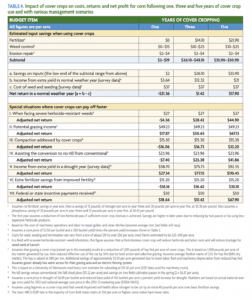
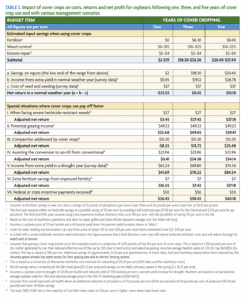
An In-Depth Look at Management Situations Where Cover Crops Pay Off Faster
As outlined earlier, there are several different management situations where cover crops pay off faster than usual. Generally, these faster returns occur where farmers are either addressing a specific problem such as herbicide resistant weeds or soil compaction, and/or where they are seizing opportunities in other aspects of their crop and soil management in order to be more economically efficient overall.
For example, Alabama farmer Annie Dee has been combining cover crops with other conservation practices for many years because of the multiple cost-saving benefits she sees. “If we get a big rain, the cover crops help keep soil from washing away,” says Dee, who farms 4,000 acres of corn and soybeans, with another 3,500 acres of forages and cattle pasture. “They also help build up the fertility of the soil and keep the weeds down.”
By using the baseline numbers on cover crops from the preceding section and then adding in the economic impact of these various management scenarios, a more specific set of economic numbers can be generated. These management-specific numbers are summarized in the “Snapshot” sections at the end of each management section. The intent here is to help producers identify those profitability factors that are relevant to their own farms.
When looking at the management situations that follow, producers or farmer advisors should keep in mind their goals for the cover crops they plan to use on each field, such as helping with compaction (Figure 1). This can help guide their selection of cover crops, help set realistic expectations on potential returns and help suggest what other management changes might be needed to improve overall efficiency.
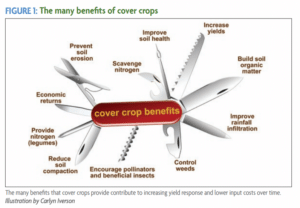
Snapshot: The financial impact from herbicide-resistant weeds
Cover crops can pay off in year one for soybeans and in year two for corn, assuming savings of $27 per acre from using cover crops when a substantial or severe herbicide-resistant infestation is occurring. Using the calculations summarized in Table 4 for corn, the increased net profit from cover crops average -$4.36, $28.42 and $44.90 per acre after one, three and five years of planting a cover crop. Using the calculations summarized in Table 5 for soybeans, the increased net profit from cover crops average $3.45, $27.42 and $37.18 per acre after one, three and five years. (See tables 4 and 5 for details.)
The $27 per acre savings is based on a comparison of using cover crops with an herbicide program to deal with herbicide resistant weeds versus using herbicides alone. Keep in mind that the occurrence of herbicide-resistant weeds normally drives up overall herbicide costs, as more expensive residual herbicides are used. Often times an extra post-emergence herbicide treatment is employed (making a second or third post-emergence application). Specifically, the $27 figure is based on a savings of $12 per acre due to one fewer post-emergence spray (assuming Roundup Powermax at $4.50 per acre plus $7.50 per acre application cost) and $15 per acre for a lower-cost residual herbicide chemistry.
This analysis assumes that a farmer who uses cover crops to combat herbicide-resistant weeds would still apply both residual herbicides and at least one or two postemergence herbicide passes to deal with them. The difference that a cover crop can make in this situation is to provide enough weed control that the farmer can avoid buying the more-expensive herbicides that would otherwise be required in order to deal with an escalating weed problem.
There may also be additional savings from not having dockage fees for weed seed contamination in the harvested grain, and from being able to buy less expensive commodity seed (such as using Roundup Ready soybeans as opposed to new varieties that have stacked traits for resistance to both Roundup and dicamba).
Snapshot: The financial impact of grazing cover crops
Cover crops pay off in year one, assuming an annual return of $49.23 per acre from grazing. Estimated returns for corn average $17.87, $50.65 and $67.13 per acre after one, three and five years of planting a cover crop. Soybean returns average $25.68, $49.65 and $59.41 per acre after one, three and five years. (See tables 4 and 5 for details.) The assumed annual return includes assumptions that portable electric fencing is already on hand and water is accessible; costs for installing new fencing or a water supply would delay profit on grazing to year two or possibly longer. Practical Farmers of Iowa, in a detailed on-farm study of cover crop grazing, also found that grazing provided a net profit in year one for each of the farms studied [6].
Positive Returns from Grazing Cover Crops
Farmer Profile: Justin Zahradka, Lawton, N.D.
PRIMARY COVER CROPS: oilseed radishes, turnips, cereal rye, oats, peas, sorghum sudangrass and hairy vetch
Justin Zahradka is no stranger to change, and he’s even more familiar with innovation. Farming the same ground his family homesteaded in 1898, Zahradka is the fifth generation living on and working their Walsh County, N.D., operation. His path to farming and adoption of cover crops began in 2011, while still in high school, with the purchase of bred heifers. Focused on data and economics even at that early point in his career, Zahradka participated in a data gathering project that examined the costs and benefits of cover crops and grazing. With support from state SARE funding, Zahradka found that cover crops enabled him to “be more productive on each acre.” Based on his work with cover crops and his overall qualifications, Zahradka was named FFA’s National Star in Agriscience for 2015.
Since that time, he has explored a number of commercial enterprises for his farm including feeder cattle, custom grazing and row crops, and he ended up with the diversified crop and livestock operation he currently operates. Cover crops have been a common denominator throughout every shift in his operation, which has grown to 900 acres including a 160 head cow-calf operation and 500 acres of row crops. On his row crop acres, Zahradka initially focused on just a couple cash crops along with cover crops, but, driven by his bottom line, he has since modified his rotation to include corn, soybeans, spring canola and wheat, with half his land in forages for year-round grazing.
Preferring mixtures to the use of single species, Zahradka typically plants a combination of oilseed radishes, turnips and cereal rye after wheat. Those acres will routinely be grazed from the end of September into November, extending forage production for his cattle. Acres targeted for forage production might see a mixture of oats, peas, sorghum sudangrass and vetch. “Those interested in a cover crop mix should start simple with one grass, one legume and one brassica in a mixture,” Zahradka advises. “Most importantly, look at cover crops as an investment rather than a cost.”
Continuous use of cover crops has netted a small but sustained 0.1% annual increase of soil organic matter in his soils, which has been verified by soil test data. When considering the value of his investment in cover crops, Zahradka also points to the resiliency of his soils in both wet and dry years and the benefit of an extended grazing season for his cow-calf operation. His data supports the conclusion that profits per animal can be greater when incorporating cover crops into an operation. In addition, Zahradka’s labor is decreased by having the livestock “do the feeding,” which enables him to expand his operation without the need to add full-time hired labor. “Cover crops can help improve your quality of life,” Zahradka says. “The operator gains labor savings by letting the livestock do their job.”
Snapshot: The financial impact of addressing compaction with cover crops
Cover crops break even for corn in year two and provide a net profit for soybeans in year two, assuming savings of $15.30 per acre from not having to do annual subsoiling. Returns for corn average -$16.06, $16.72 and $33.20 after one, three and five years of planting a cover crop. Soybean returns average -$8.25, $15.72 and $25.48 after one, three and five years. (See tables 4 and 5 for details.) A positive net return could be delayed to year three if subsoiling is done less frequently than on an annual basis.
Addressing Compaction, Erosion and Weeds
Farmer Profile: Mike Taylor, Helena, Ark.
PRIMARY COVER CROPS: cereal rye and mixes
A sign hangs in Mike Taylor’s shop that reads, “You do not inherit the land from your ancestors, you borrow it from your children.” Taylor and his father vividly remember 1992 as a year that challenged that statement. High wind conditions combined with their light, sandy soils resulted in sandblasting and a near-total loss of their cotton crop. The following year they began adding cover crops into their cotton rotation to keep their soil in place, and their use of cover crops has increased every year since. Cover crops are now normally used on 90% of their roughly 4,000 acres of row crops in east Arkansas near Helena. “I want my ground to be there for my kids,” Taylor says.
Taylor plants cereal rye as his cover crop of choice in their corn, soybean, peanut and cotton rotation, but he has incorporated blends as well and has even made use of 12- and 13-way mixes. He primarily seeks to prevent soil erosion and promote root growth below the soil surface. Cover crops have also helped to control herbicide-resistant Palmer amaranth and horsetail (marestail) on the farm.
For producers in his region considering a cover crop, Taylor advises to “drill it in and plant early.” He has tried many options for planting but prefers his no-till drill because it allows him to cut back his seeding rate and he always gets a stand. Taylor has seen producers who plant too late and terminate too early to receive maximum benefits, making their cover crops less profitable. In 2018, Taylor had some issues with slugs for the first time and is searching for a cost-effective remedy if they recur.
Taylor likes to point out that many people focus on annual expenses and potential savings with cover crops, but one area that has not received the same amount of attention is the change in equipment needs. To address his hardpan issues, Taylor drills cover crops instead of running a subsoiler tillage tool, thereby avoiding the fuel and labor cost associated with using his high-horsepower tractor. “I look at my no-till drill as my subsoiler,” he says.
Taylor also notes that cover crops seem to resolve the soil crusting issues they historically had. Thus, they rarely need to run their rotary hoe. A trackhoe implement, which was purchased years earlier to dig out eroded soil that filled up drainage ditches, is now seldom needed since cover crops have significantly reduced erosion on his fields. The machinery cost savings and better weed control have positively impacted his bottom line and help justify his effort to increase soil health, ensuring his children will have the same opportunity to farm.
Snapshot: The financial impact of using cover crops to ease the transition to no-till
Cover crops pay off starting in their second year of use for corn and break even during the first year of use with soybeans, assuming savings of $23.96 per acre from using cover crops to help the transition to no-till. The assumed savings are from the reduced fuel and labor costs of doing one fewer fall tillage pass and two fewer spring tillage passes. Returns for corn average -$7.40, $25.38 and $41.86 per acre after one, three and five years of planting a cover crop. Soybean returns average $0.41, $24.38 and $34.14 per acre after one, three and five years. (See tables 4 and 5 for details.)
Deeper Rooting Builds Resilience into the Cropping System
Farmer Profile: Ralph “Junior” Upton, Springerton, Ill.
PRIMARY COVER CROPS: cereal rye, ryegrass and hairy vetch
Junior Upton’s history with cover crops began almost 50 years ago with frost-seeded red clover into winter wheat. Producing corn and soybeans on 1,800 acres about 100 miles east of St. Louis, Mo., Upton recalls that his original interest in cover crops and no-till arose from a desire to limit soil erosion. Although he has never lost sight of this benefit, his many years of planting cover crops and seeing the enormous positive impact they have on the resilience of his soil has expanded his appreciation of them. Cover crops have literally improved his ability to weather storms, he says.
Upton has experimented with multiple cover crop species, including buckwheat, radishes, rapeseed, cereal rye, vetches and ryegrass. He explains that trial and error along with in-field research through partnerships with programs such as SARE have enabled him to pinpoint cover crop mixtures that work with his management system. Upton no-till drills a three-way mix of cereal rye, ryegrass and hairy vetch after both corn and soybeans. He has a specific reason for each cover crops he relies upon. Cereal rye helps with weed control and soil erosion, and is a great companion crop for the other cover crops. The root system of ryegrass helps to break up the fragipan in his soil and also assists with weed control. When managed properly, hairy vetch generates both supplemental nitrogen and additional weed control.
Upton recalls introducing ryegrass into his system and seeing roots 48 inches deep, growing through the fragipan, even though above-ground biomass was less than five inches tall. Being vulnerable to droughts was an ongoing concern in the past, but now cover crops have helped to alleviate some of that worry by improving both the water-holding capacity of his soil and the rooting depth of his corn and soybeans. “Dry weather killed me in the past due to a fragipan,” Upton explains. “I had been farming the top five inches of soil, where now I use four feet of soil.”
When discussing his conservation practices, Upton quickly points to his focus on the bottom line and how his farm management has changed over the years. Switching to no-till and cover crops in the mid-90s decreased his capital outlay for equipment and lessened his fuel bill. Now, after years of experience, Upton has tweaked his management again. By using different seed maturity groups and slightly later planting dates, he has been able to reap additional soil health benefits, reduce fertilizer inputs and get better weed control. He has also seen improved profit, in part due to better yields where he has used cover crops. Upton recommends that producers take the time to evaluate their own situation, soils and management priorities. “What works for me may not work out as well on someone else’s farm,” he says.
The bottom line for Upton is that every acre on his farm is destined to have a cover crop. He looks forward to additional breeding work with cover crops and hopes to take advantage of additional benefits in the future, such as increased nitrogen availability.
How stewardship generates value for farmers, lenders, insurers and landownersReport of the Environmental Defense Fund
In a survey of 2,000 Midwestern and Northern Great Plains farmers, 64% said they were implementing conservation practices (no-till or reduced tillage, cover crops, etc.) as a climate risk management strategy, and another 21% were considering implementing such practices.
Snapshot: The financial impact of cover crops during a drought
Based on data from the 2012 drought, cover crops significantly boost yield (on average) during a drought year, and cover crops pay off in year one. Returns for corn average $27.34, $77.15 and $110.45 per acre after one, three and five years of planting cover crops. Soybean returns average $41.69, $70.22 and $84.54 per acre after one, three and five years. (See tables 4 and 5 for details.) For the purpose of this analysis, the one-, three- and five-year increments mean that cover crops had been used for that amount of time when a drought occurred.
Snapshot: The financial impact of extra fertilizer savings
Cover crops break even in year two for corn and pay off by year three for soybeans, assuming a field situation where soil fertility can be improved by cover crops. Returns for corn average -$16.16, $16.62 and $33.10 per acre after one, three and five years of planting a cover crop. Soybean returns average -$16.55, $7.42 and $17.18 per acre after one, three and five years. (See tables 4 and 5 for details.) See the footnotes in tables 4 and 5 for details on specific fertilizer assumptions.
Snapshot: The financial impact of incentive payments for cover crops
Cover crops pay off in year one, assuming an incentive payment rate of $50 per acre, based on typical NRCS EQIP rates in the Corn Belt. Returns for corn average $18.64, 51.42 and $67.90 per acre after one, three and five years of planting a cover crop. Soybean returns average $26.45, $50.42 and $60.18 per acre after one, three and five years. (See Tables 4 and 5 for details.) The majority of states have a “basic” cover crop incentive payment rate of $50 per acre or more, and rates for multi-species cover crops, beginning or organic farmers, or underserved audiences can be even higher. A minority of states have a basic cover crop incentive rate below $50 per acre. (See Table 6.) Applications for incentive payments are not guaranteed to be funded, but as long as guidelines are met, generally a majority of applications are approved. As stated previously, these incentive payments should be viewed in the context of providing transition support rather than as a long-term economic subsidy.
Data Drives Fertility Decisions
Farmer Profile: Ken Rulon, Rulon Enterprises, Arcadia, Ind.
PRIMARY COVER CROPS: cereal rye, annual ryegrass, oats, radish, clover, rapeseed and hairy vetch
To say that data drives decisions for Ken Rulon is an understatement. Utilizing one-acre grid sampling for twenty-four years, Rulon and his family have learned there is a linear relationship between soil organic matter and yield. “The data is clear. We need something growing on the soil at all times,” Rulon says. He farms approximately 6,000 acres with his family in northcentral Indiana. This fourth-generation family farm has used notill management since 1989 and started using cover crops around 2006. Their general philosophy is that conservation is the best economic model and that oxidizing soil carbon through tillage is not sustainable long term.
Once they combined cover crops with no-till, Rulon’s soil organic matter levels increased more than 1% over the next decade on some fields. With cover crops, he documented increased soil moisture during the growing season, decreased soil surface temperatures, increased soil aggregate stability, increased soil organic matter levels and improved yields.
One of Rulon’s primary goals with cover crops has been to increase soil organic matter levels and reduce input costs. He notes that research at Purdue University found cover crops reduced nitrogen leaching by 50%. Through his own experience, years of cover cropping has allowed Rulon to cut fertilizer use and still maintain adequate soil fertility levels. He reduced phosphorus inputs by 20 pounds per acre, potassium by 30 pounds per acre and nitrogen by 35 pounds per acre. In-field trials conducted for multiple years with multiple rates of nitrogen fertilizer demonstrate that 165 pounds of nitrogen per acre achieves maximum economic yields for his operation. This compares to the more typical rate for his region of 200 pounds of nitrogen per acre for corn.
The cost savings that come from reducing his fertilizer inputs has not resulted in lower yields. In fact, Rulon’s operation consistently achieves yields higher than the county average. Multiple years of yield data confirm a yield benefit of approximately seven bushels per acre for corn and almost two bushels per acres for soybeans.
Profitability aside, Rulon believes managing a sustainable operation implies they must meet their present needs without sacrificing the future. That is why he appreciates the role cover crops and no-till play in protecting the soil, sequestering carbon and improving the overall resilience of the farm. “We encourage everyone to develop data for their operation to find the system that works best on your soils and in your region,” Rulon says.
The Off-Farm Impacts of Cover Crops
The real-world effect of farm activities extends well beyond the farm gate. Collectively, the activities of farming operations affect not only regional ecosystems but also rural communities and society as a whole. As part of a holistic review of cover crop economics, it is worth noting some of the ways that cover crops can influence off farm economics, especially in a consumer culture where buyers increasingly want to know the origin and environmental impact of the products they buy.
The Bottom Line on Cover Crops
To be sure, determining the economic impact of planting a cover crop is not as simple as a one-year, cost-and return analysis. Ultimately, the decision to plant a cover crop should be viewed as an investment in the long-term resilience of the farm. Many factors, from particular on-farm challenges to the gradual accrual of soil health benefits, will influence when cover crops start to pay off.
When do cover crops start to pay?
With all of the variables described in this bulletin, it’s probably safe to say that often, by year three, cover crops will be paying for themselves, if not earlier. There are times when that return on investment could take a little longer, but there are even more situations in which that return can be accelerated. This happens most often when a cover crop is meeting particular on-farm needs, such as dealing with herbicide-resistant weeds, reducing soil compaction, helping with soil moisture management and soil fertility, or providing grazing opportunities.
What is the soil health impact from cover crops three to five years down the road?
After three to five years of annual use, well-managed cover crops should start to bring about soil health improvements that improve yields and save on input costs. Not all soil health measures will respond equally fast. For example, earthworm activity and some bacteria and fungi will respond within the first year of cover crop use. However, it can take five years or more before soil organic matter starts to noticeably improve, depending on how the cover crops are managed and what tillage is done. A key point is that cover crop benefits keep accruing over several years. The economic return at year five should generally be greater than year three, and year seven should be greater than year five.
What is the bottom-line economic impact?
A positive first-year return from cover crop use will often occur during drought conditions, where cover crops are grazed (assuming that grazing infrastructure is already in place), or potentially in a situation with challenging herbicide-resistant weeds. When converting from conventional till to no-till, cover crops can help ease that transition, making it possible to break even in year one for soybeans and to make a small return by year two with corn. When compaction or soil fertility is limiting yield, cover crops may provide a positive net return by the second year. Receiving incentive payments from federal or state government programs can also make it possible to immediately pay for the cost of cover cropping during a transition period.
Under the most conservative assumptions for the analysis reported here, where there are no particular issues being addressed, no incentive payments or grazing, and normal rainfall, it will take on average about three years of planting a cover crop for the practice to break even or provide a net profit, not unlike applying lime to address soil pH. By year five, on most fields, cover crops should be producing a modest profit due to a combination of yield increases and somewhat lower production costs.
The contribution cover crops make to farm resiliency is also underappreciated. Consider that the majority of farmers carry crop insurance to reduce risk. Cover crops are a form of risk management like crop insurance; investing in them to improve soil health will help reduce future risk from weather extremes. Significant cover crop payoffs have been documented in drought years, where yield increases of more than 10% may be seen. Even in wet years there can be a noticeable benefit from the improved aeration and soil structure provided by cover crops, allowing spring planting or fall harvest to start two to three days earlier following cover crops.
Ultimately, a broad-based, holistic perspective is helpful in factoring in all the different ways that cover crops can benefit a field and a farm. As farmers gain experience with cover crops, they end up making other management changes that complement the cover crops and maximize their overall economic efficiency while improving the sustainability of their farming livelihood. The bottom line is that cover crops should be valued both for their immediate benefits and as an investment in the long-term success of the farm.
Resources and References
The NRCS “cover crop economics tool” is a free downloadable spreadsheet that evaluates the cover crop payoff period based on the user’s data. Interpretative materials and supportive videos are also available through the NRCS website. Additionally, NRCS has an extensive series of soil health fact sheets and videos available through their website. Search “NRCS soil health.” SARE has multiple publications and online resources pertaining to cover crops, including:
- Managing Cover Crops Profitably (www.sare.org/mccp)
- Building Soils for Better Crops (www.sare.org/bsbc)
- The Cover Crops topic room, an extensive set of cover crop resources (www.sare.org/covercrops)
The nonprofit Soil Health Institute offers a growing number of publications and videos pertaining to cover crops and soil health. See www.soilhealthinstitute.org.
References
- Basche, A. 2017. Turning soils into sponges: how farmers can fight floods and droughts. Union of Concerned Scientists.
- Bruggink, D. 2018. Cover crop train keeps rolling on. No-Till Farmer magazine blog: March 10, 2018.
- California Carbon Dashboard. 2018. Carbon price. Climate Policy Initiative.
- Congressional Research Service. 2018. Federal Crop Insurance: Program Overview for the 115th Congress. Library of Congress report R45193.
- Conservation Technology Information Center (CTIC). 2013–2017. Annual reports of the National Cover Crop Survey. Joint publication of CTIC and SARE.
- Filbert, M. 2017. Economic impact of grazing cover crops in cow-calf operations. Practical Farmers of Iowa: Ames, IA.
- Hanna, M., and M.M. Al-Kaisi. 2009. Understanding and managing soil compaction. Iowa State University Extension publication PM1901b.
- Hoorman, J., R. Islam, A. Sundermeier and R. Reeder. 2009. Using cover crops to convert to no-till. Ohio State University Extension guide SAG–11.
- Johnson, C. 2017. Cotton in cover. Furrow Magazine: October 30, 2017.
- Lal, R. 2014. Societal value of soil carbon. Journal of Soil Water Conservation 69(6): 186A–192A.
- Lazarus, W.F. 2018. Machinery cost estimates. University of Minnesota.
- Monast, M., L. Sands and A. Grafton. 2018. How stewardship generates value for farmers, lenders, insurers and landowners. Report of the Environmental Defense Fund.
- Sundermeier, A. and R. Reed. 2013. Tillage, cover crop, and compaction effects on corn and soybeans. Ohio State University research reports.
- Sunderlage, B. 2019. Presentation on cover crops and weeds at 2019 Midwest Cover Crop Council Annual Conference. Springfield, IL.
- Tang, C., G.E. Lade, D. Keiser, C. Kling, Y. Ji and Y. Shr. 2018. Economic benefits of nitrogen reductions in Iowa. Iowa State University Center for Agricultural and Rural Development.
- Tellatin, S. and R. Myers. 2018. Cover crop impacts on U.S. cropland carbon sequestration. Journal of Soil Water Conservation 73(5): 117A–121A.
- Tellatin, S. and R. Myers. 2018. Cover crops at work: Keeping nutrients out of waterways. USDA-SARE cover crop fact sheet series.
- Tellatin, S. and R. Myers. 2018. Cover crops at work: Cover the soil to prevent erosion. USDA-SARE cover crop fact sheet series.
- Wilcoxen, C.A., J.W. Walk and M.P. Ward. 2018. The use of cover crop fields by migratory and resident birds. Agriculture Ecosystems and Environment 252: 42–50.
This bulletin was written by Rob Myers (University of Missouri and North Central SARE), Alan Weber (MARC-IV Consulting), and Sami Tellatin (University of Missouri). The authors appreciate the helpful review comments provided by Lauren Cartwright, Wayne Honeycutt, Jim Hoorman, Eileen Kladivko, Kim Kroll, Lynn Knight, Steven Mirsky, Josh Payne, Wally Tyner, Andy Zieminski and Lizi Barba. The authors also thank Stacy Zuber for help with yield data analysis, and the Conservation Technology Information Center and American Seed Trade Association for their involvement in the National Cover Crop Survey.
This material is distributed by SARE Outreach for the SARE Program and based upon work supported by the National Institute of Food and Agriculture, U.S. Department of Agriculture, under award number 2015-38640-23778. SARE Outreach operates under cooperative agreements with the University of Maryland to develop and disseminate information about sustainable agriculture.
This publication was developed by the Sustainable Agriculture Research and Education (SARE) program with funding from National Institute of Food and Agriculture, USDA. Any opinions, findings, conclusions or recommendations expressed here do not necessarily reflect the view of the U.S. Department of Agriculture.
Continue Learning About the CIBO Certified Crop Advisor Program
Return to the pathway to build your knowledge of information about the certified crop advisor program.
Return to Pathway
